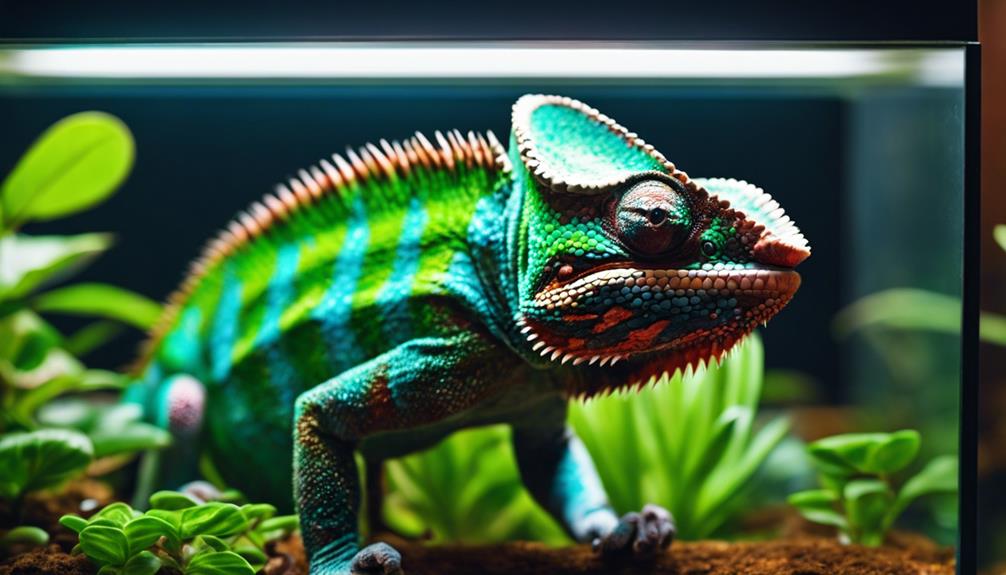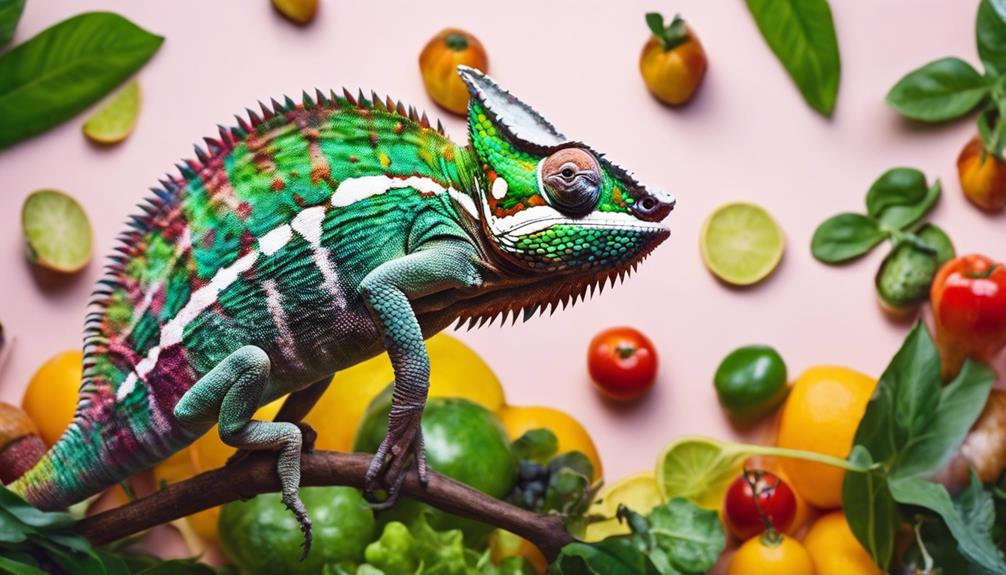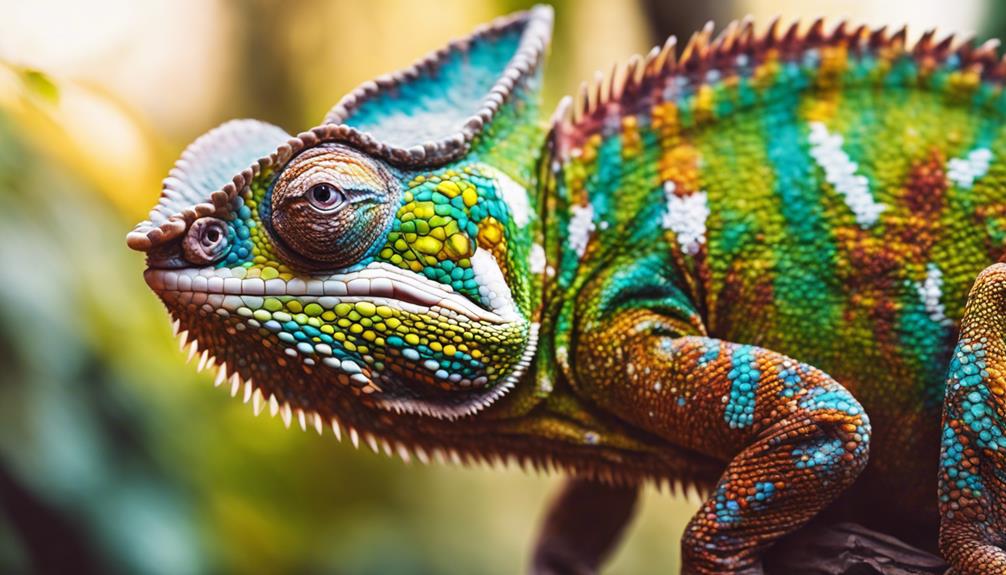Selecting suitable plants for your panther chameleon’s habitat may seem simple, but have you considered the safety aspect? Ensuring your chameleon’s environment is not just aesthetically pleasing but also non-toxic is paramount.
The wrong plant choice could lead to unforeseen consequences for your pet. So, how can you guarantee a lush and secure sanctuary for your panther chameleon?
Safe Plants for Panther Chameleons
When selecting plants for your Panther chameleon’s habitat, make sure you choose safe options like Ficus benjamina and Schefflera arboricola to provide essential features for their well-being. These safe plants not only offer hiding spots and climbing opportunities but also add visual appeal to the terrarium. Panther chameleons thrive in environments that mimic their natural habitat, and incorporating these safe plants can enhance their overall quality of life.
Ficus benjamina, commonly known as the Weeping Fig, is an excellent choice as it provides ample coverage for your chameleon to hide and explore. Schefflera arboricola, also called the Umbrella Plant, offers a diverse structure for climbing and basking. Both plants are visually attractive and contribute to creating a stimulating environment for your Panther chameleon.
For those looking to further enrich their chameleon’s habitat, consider adding Pachira aquatica (Money Tree) and Radermachera sinica (China Doll Plant) to the terrarium. These safe plant options can elevate the well-being and natural habitat experience of your Panther chameleon.
Toxic Plants to Avoid
To keep your Panther chameleon safe and healthy, it’s important to be aware of toxic plants that should be avoided in their habitat, such as Philodendrons and Fiddle-leaf figs. These plants can pose serious health risks if ingested by your chameleon.
Here are some other toxic plants to steer clear of:
- Creeping figs
- Crotons
- Zulu Figs
These plants contain substances that can be harmful to Panther chameleons, causing digestive issues and other health problems. Philodendrons, in particular, are known for their toxicity and should never be included in your chameleon’s terrarium.
It’s vital for Panther chameleon owners to thoroughly research and identify toxic plants to promote a safe environment for their beloved pets. By being proactive and avoiding these harmful plants, you can help promote the well-being and longevity of your Panther chameleon.
Best Plants for Chameleon Enclosures
What plants are considered ideal for Panther chameleon enclosures to promote their well-being and natural habitat? Safe plants like Golden Pothos, Weeping Fig, and Dracaena Compacta are excellent choices. These plants not only provide hiding spots and climbing opportunities for your chameleons but also contribute to their overall well-being.
By including these safe plants in the enclosure, you can create a habitat that mimics their natural environment, promoting their health and behavioral needs. It’s essential to avoid toxic plants like Philodendrons or Fiddle-Leaf figs, as they can pose health risks to your chameleons.
Edible Plants for Chameleons
Enhance the nutritional balance and health of your Panther chameleons by incorporating safe and edible plants into their diet.
- Diversify their Diet: Offering a variety of safe edible plants like Pothos leaves and kale can provide essential nutrients that contribute to the overall well-being of your panther chameleons.
- Include Leafy Greens: Dark, leafy greens such as romaine lettuce are excellent options to enrich the diet of your chameleons, ensuring they receive a good mix of vitamins and minerals.
- Maintain Health: Edible plants play a critical role in maintaining the nutritional balance and health of your panther chameleons, supporting their immune system and overall vitality.
Plant Care Tips for Chameleon Habitats
Panther chameleons thrive in habitats that are enriched with a variety of safe plants like Pothos, Ficus, and Schefflera, contributing to their overall well-being and health. When caring for plants in a chameleon habitat, it’s crucial to make sure they’re safe for your pet. Opt for plants that have been Veiled Chameleon tested and are known to be safe for chameleons.
Regularly clean the plant leaves with water and mild soap to prevent dust buildup, which can impact the chameleon’s health. Additionally, consider adding plants like Hibiscus and Areca Palm to create hiding spaces and mimic the chameleon’s natural environment. These plants not only provide aesthetic value but also contribute to a comfortable setting for your chameleon.
Remember to avoid toxic plants such as English Ivy and Golden Pothos, as they can be harmful to your pet. By selecting the best plants and maintaining proper plant care in your chameleon cage, you can create a tropical paradise that promotes your chameleon’s well-being.
Frequently Asked Questions
Can You Put Real Plants in With a Chameleon?
You can indeed put real plants in with a chameleon to create a natural habitat. Consider options like Golden Pothos and Ficus for decor, environmental enrichment, and vivarium setup. Guarantee plant care, watch for toxicity, and provide leafy greens for chameleon benefits.
Is the Chameleon Plant Poisonous?
The Chameleon Plant is non-toxic to chameleons, making it a safe option for their habitat. It offers colorful foliage, and visual interest, and thrives in warm, humid conditions. Consider it for a chameleon enclosure.
Are Fake Plants Safe for Chameleons?
Artificial plants provide less humidity and enrichment in a chameleon enclosure. Opt for live plants to enhance chameleon health and habitat. Fake plants lack benefits for chameleon diet and behavior. Choose wisely for a thriving habitat.
What Pothos Are Safe for Chameleons?
For your chameleon habitat, consider safe Pothos varieties like Golden, Marble Queen, Neon, Jade, and Satin. Place them strategically for climbing and hiding spots. These plants benefit their diet, and need proper lighting, care, and humidity levels, ensuring chameleon health.
Conclusion
To sum up, when it comes to providing a safe and enriching environment for your panther chameleon, choosing the right plants is essential. By opting for non-toxic options like Golden Pothos and Weeping Fig, you can guarantee that your chameleon has hiding spots and climbing opportunities without any health risks.
Remember to avoid toxic plants and incorporate edible options for added benefits. With proper plant care, you can create a vibrant habitat that promotes the well-being of your beloved chameleon.


